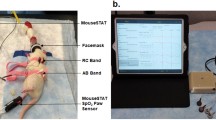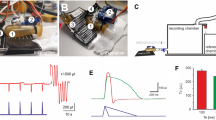Abstract
During proportional assist ventilation (PAV), the ventilator pressure is servocontrolled throughout each spontaneous inspiration such that it instantaneously increases in proportion to the airflow (resistive unloading mode), or inspired volume (elastic unloading mode), or both (combined unloading mode). The PAV pressure changes are generated in a closed-loop feedback circuitry commonly using a pneumotachographic signal. In neonates, however, a pneumotachograph increases dead space ventilation, and its signal may include a substantial endotracheal tube leak component. We hypothesized that respiratory inductive plethysmography (RIP) can replace pneumotachography to drive the ventilator during PAV without untoward effects on ventilation or respiratory gas exchange. Ten piglets and five rabbits were supported for 10-min (normal lungs) or 20-min (meconium injured lungs) periods by each of the three PAV modes. In each mode, three test periods were applied in random order with the ventilator driven by the pneumotachograph signal, or the RIP abdominal band signal, or the RIP sum signal of rib cage and abdomen. Interchanging the three input signals did not affect the regularity of spontaneous breathing, and gas exchange was achieved with similar peak and mean airway pressures (ANOVA). However, the RIP sum signal worked adequately only when the relative gains of rib cage and abdominal band signal were calibrated. We conclude that an RIP abdominal band signal can be used to generate PAV, avoiding increased dead space and endotracheal tube leak problems.
Similar content being viewed by others
Log in or create a free account to read this content
Gain free access to this article, as well as selected content from this journal and more on nature.com
or
Abbreviations
- AB:
-
RIP signal from abdominal band
- CPAP:
-
continuous positive airway pressure
- Paco2:
-
arterial Pco2
- Pao2:
-
arterial Po2
- PAV:
-
proportional assist ventilation
- RC:
-
RIP signal from rib cage band
- RIP:
-
respiratory inductive plethysmography
- Sum:
-
sum signal of AB and RC
- TCD:
-
total compartmental displacement
References
Younes M, Puddy A, Roberts D, Light RB, Quesada A, Taylor K 1992 Proportional assist ventilation: results of an initial clinical trial. Am Rev Respir Dis 145: 121–129
Younes M 1992 Proportional assist ventilation, a new approach to ventilatory support: theory. Am Rev Respir Dis 145: 114–120
Poon CS, Ward SA 1986 A device to provide respiratory-mechanical unloading. IEEE Trans Biomed Eng 33: 361–365
Schulze A, Schaller P, Töpfer A, Kirpalani H 1993 Resistive and elastic unloading to assist spontaneous breathing does not change functional residual capacity. Pediatr Pulmonol 16: 170–176
Schulze A, Schaller P, Gehrhardt B, Mädler HJ, Gmyrek D 1990 An infant ventilator technique for resistive unloading during spontaneous breathing: results in a rabbit model of airway obstruction. Pediatr Res 28: 79–82
Schulze A, Schaller P, Jonzon A, Sedin G 1993 Assisted mechanical ventilation using elastic unloading: a study in cats with normal and injured lungs. Pediatr Res 34: 600–605
Schulze A, Suguihara C, Gerhardt T, Schaller P, Claure N, Everett R, Bancalari E 1998 Effects of respiratory mechanical unloading on thoracoabdominal motion in meconium-injured piglets and rabbits. Pediatr Res 43: 191–197
Sackner MA, Gonzalez H, Rodriguez M, Belsito A, Sackner DR, Grenvik S 1984 Assessment of asynchronous and paradoxic motion between rib cage and abdomen in normal subjects and in patients with chronic obstructive pulmonary disease. Am Rev Respir Dis 130: 588–593
Adams JA, Zabaleta IA, Stroh D, Johnson P, Sackner MA 1993 Tidal volume measurements in newborns using respiratory inductive plethysmography. Am Rev Respir Dis 148: 585–588
Allen JL, Greenspan JS, Deoras KS, Keklikian E, Wolfson MR, Shaffer TH 1991 Interaction between chest wall motion and lung mechanics in normal infants and infants with bronchopulmonary dysplasia. Pediatr Pulmonol 11: 37–43
Wilkes DL, Revow M, Bryan MH, England SJ 1987 Evaluation of respiratory inductive plethysmography in infants weighing less than 1,500 grams. Am Rev Respir Dis 136: 416–419
Sackner MA, Watson H, Belsito AS, Feinerman D, Suarez M, Gonzalez G 1989 Calibration of respiratory inductive plethysmograph during natural breathing. J Appl Physiol 66: 410–420
Schaller P, Schulze A 1991 A ventilator generating a positive or negative internal compliance. Ups J Med Sci 96: 219–234
Author information
Authors and Affiliations
Additional information
Supported in part by the University of Miami Project New Born.
Rights and permissions
About this article
Cite this article
Schulze, A., Suguihara, C., Gerhardt, T. et al. Inductance Plethysmography: An Alternative Signal to Servocontrol the Airway Pressure during Proportional Assist Ventilation in Small Animals. Pediatr Res 49, 169–174 (2001). https://doi.org/10.1203/00006450-200102000-00007
Received:
Accepted:
Issue date:
DOI: https://doi.org/10.1203/00006450-200102000-00007



